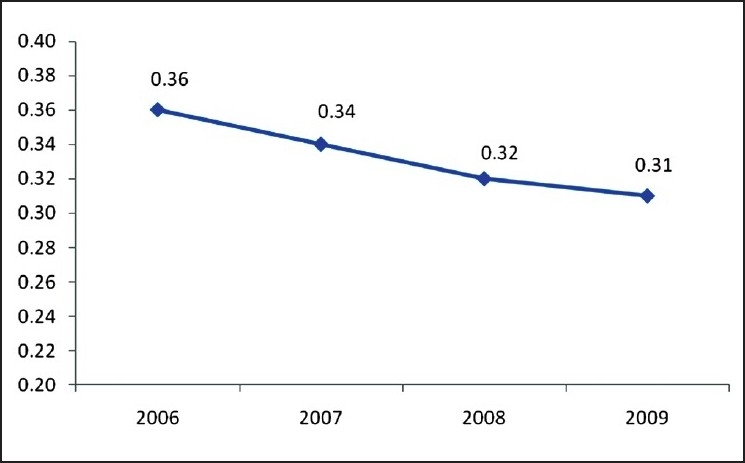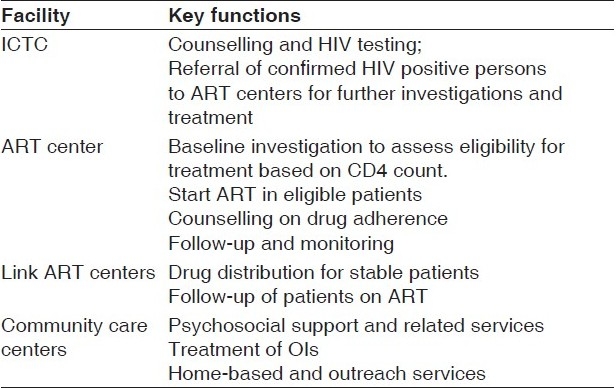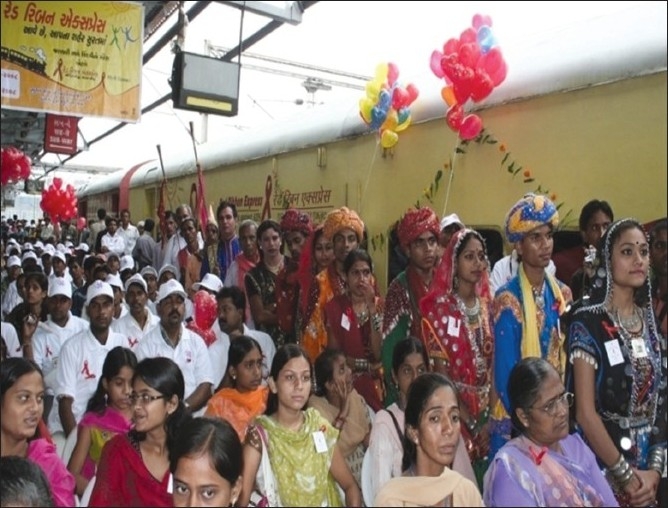Introduction
Available evidence on HIV epidemic in India shows a stable trend at a national level. The provisionally estimated number of people living with HIV in India is 2,390,000, with an estimated adult HIV prevalence of 0.31% in 2009(1) [Figure 1]. HIV/AIDS is concentrated among high-risk group populations and is heterogeneous in its spread. The primary drivers of HIV epidemic in India are unprotected paid sex, unprotected sex between men and injecting drug use. Heterosexual route of transmission accounts for 87% of the HIV cases detected.(1) In the north-eastern part of the country, however, injecting drug use is the major cause for the epidemic spread; sexual transmission comes next. Over the years, the HIV/AIDS epidemic has moved from urban to rural India and from high-risk to general population, largely affecting youth.
Figure 1.

HIV Prevalence among adult population, India (2006-09)
National AIDS Control Programme (NACP) aims to contain the spread of HIV in India by building all-encompassing response reaching out to diverse populations. The overall goal of NACP-III (2007-2012)(2) is to halt and reverse the epidemic in India by 2012 by integrating programs for prevention, care and support and treatment. This will be achieved through a four-pronged strategy:
Prevention of infections through saturation of coverage of high-risk groups with targeted interventions (TIs) and scaled up interventions in the general population;
Provision of greater care, support and treatment to larger number of people living with HIV/AIDS (PLHA);
Strengthening the infrastructure, systems and human resources in prevention, care, support and treatment programs at district, state and national levels and
Strengthening the nationwide Strategic Information Management System (SIMS).
Program Implementation
To meet the above objectives, various interventions were initiated with clearly defined technical and operational guidelines and monitoring indicators, which are constantly reviewed. The National AIDS Control Organisation (NACO)(3) under Department of AIDS Control of the Ministry of Health and Family Welfare is the overall body for framing policy, guidelines and strategies for program implementation. It also releases funds to various states and reviews the progress under various components of the program.
State AIDS Control Societies (SACS) have been constituted throughout the country with the responsibility of program implementation. In high HIV prevalent districts, District AIDS Prevention Control Unit (DAPCU) has been set up for direct supervision at the ground level.
Program Components
Targeted interventions
HIV epidemic in India is mainly concentrated in high-risk population like female sex workers (FSW), men having sex with men (MSM), injecting drug users (IDU) and clients of sex workers.Given their special vulnerabilities, prevention strategies include five elements – behaviour change, treatment for sexually transmitted infections (STI), monitoring access to and utilization of condoms, ownership building and creating an enabling environment. Prevention strategy of NACP-III includes peer led interventions by Non-Governmental Organizations (NGOs)/Community Based Organizations (CBOs), both in the rural and urban areas. These are networked and linked to general healthcare facilities to ensure that HRG s' access them without stigma or discrimination; they are also linked to Community Care Centers (CCC), Counseling and Testing Centers and anti-retroviral treatment (ART) centers.
TIs are aimed to effect behavior change for having protected sex through awareness rising among the high-risk groups and clients of sex workers or bridge populations, particularly single male migrants and long distance truckers.
At present, 1375 TI projects are being implemented by SACS and about 220 projects are managed by partners. Of the estimated number of high-risk groups, the coverage has been 78.3% of FSW, 70.3% of IDU and 76.2% of MSM and transgender populations.
Management of STI
STI and Reproductive Tract Infections (RTI) are key determinants of HIV transmission. An estimated 6% of adult population suffers from STI/RTI annually, accounting for about 30 million episodes per year. Presence of STI increases the risk of acquisition and transmission of HIV infection five to ten times. Control of STI provides a window of opportunity for prevention of new HIV infection and is the most cost-effective means for preventing HIV transmission. Provision of standardized package of STI/RTI services through syndromic case management by public health facilities and preferred private practitioners is the cornerstone of the program. Pre-packaged, color-coded syndromic drug kits are being supplied through the program to ensure compliance to treatment.
During the year 2009-2010, 8,240,000 STI episodes were managed. The target for NACP-III is to treat 15,000,000 STI/RTI episodes by the end of NACP-III.
Condom promotion
Condom promotion strategy aims to integrate the use for family planning as well as prevention of HIV and STI using various channels of supply, i.e. free, through social marketing and commercial outlets. In addition, various innovative approaches have been introduced including Condom Vending Machines (CVMs) at strategic sites, female condoms particularly for FSW and special condoms for MSM population.
During 2009-2010, 2,160,000,000 condom pieces were distributed which included 840,000,000 by social marketing, 600,000,000 by free distribution and 720,000,000 through commercial sale. More than 21,000 CVMs have been installed in various states, including metros and major cities, across the country.
Blood safety
Blood Safety program under NACP-III aims to ensure provision of safe and quality blood to the far-flung remote areas of the country in the shortest possible time through a well-coordinated National Blood Transfusion Service. This is sought to be achieved by the following:
Strengthening infrastructural facilities and establishing blood storage centers in the primary health care system for availability of blood in far-flung remote areas;
Ensuring that regular (repeat) voluntary non-remunerated blood donors constitute the main source of blood supply through phased increase in donor recruitment and retention;
Vigorously promoting appropriate use of blood, blood components and blood products among the clinicians;
Developing long-term policy for capacity building to achieve efficient and self-sufficient blood transfusion services;
Mandatory testing of each unit of blood for HIV, Hepatitis B and C, Syphilis and Malaria and
Voluntary blood donation for which camps are organized with the help of various organizations.
Presently, the government is supporting 1124 blood banks in the country, including 10 Model Blood Banks and 137 blood component separation units, to promote appropriate clinical use of blood. It has also been planned to set up four Centres of Excellence in Transfusion Medicine (Metro Blood Banks) in New Delhi, Mumbai, Chennai and Kolkata. A Plasma Fractionation Centre will be established with a processing capacity of 150,000 l of plasma annually to meet the ever increasing demand of hemophilia patients and other clotting factor deficiency patients. NACO along with National Rural Health Mission (NRHM) has taken the initiative to establish blood storage centers in First referral Units (FRU) where a full-fledged blood bank is neither feasible nor required.
Against an annual requirement of 8,500,000 units/year, the availability of blood in government supported blood banks is only 4,400,000 units/year. The remaining demand is met through blood banks in private hospital/private commercial blood banks. During 2009-2010, voluntary blood donation was increased to 76.1%, against our target of 75%. A total of 2,880,000 units of blood were collected by organizing more than 60,000 VBD camps in 2009-2010.
Integrated counseling and testing services
Counseling and HIV testing services are being provided through 5223 Integrated Counselling and Testing Centres (ICTC) mainly located in government hospitals. These services are also being expanded in PHC/CHC in the rural areas, private sector facilities and mobile clinics.
The main functions of an ICTC include HIV diagnostic tests, counseling and promoting behavioral change and referral for care and treatment services. The ICTC services are accessed by voluntary clients (who visit the ICTC on their own), provider initiated client testing including patients with signs/symptoms of HIV infection, patients with STI/RTI/TB and pregnant women visiting antenatal clinics.
During the year 2009-2010, more than 14,300,000 people availed counseling and testing services including 6,119,000 pregnant women. Nearly, 300,000 people were detected HIV positive during the year. A total of 12,282 mother-baby pairs were given prophylaxis dose of Nevirapine. In addition, 38,196 patients co-infected with HIV and TB were diagnosed and treated.
Care, support and treatment
The care, support and treatment needs of HIV positive people vary with the stage of the infection. The HIV infected person remains asymptomatic for 6-8 years. As immunity falls over time, the person becomes susceptible to various Opportunistic Infections (OIs). At this stage, medical treatment and psychosocial support are needed. ART and prompt diagnosis and treatment of OIs improve the survival and quality of life.
Care support and treatment services are provided through various facilities closely linked with each other, with a defined referral system as illustrated in Table 1. Selected ART centers are upgraded as Centers of Excellence (CoE) for tertiary care, training and operational research.
Table 1.
Key functions of facilities for diagnosis and treatment of HIV/AIDS

At present, nearly 1,000,000 people living with HIV/AIDS are registered for treatment and 350,000patients are being provided free ART, including 20,000 children.
Information, education, communication and mainstreaming
Information, Education and Communication (IEC) cuts across all program components of NACP-III.(2) There has been a strategic shift in IEC strategy during NACP-III, with the focus moving on to behavior change communication from just awareness creation during NACP-II.
NACO has undertaken extensive campaigns to raise awareness and strengthen health seeking and safe preventive behavior among people toward HIV. Thematic campaigns are designed and undertaken using mass media, mid media, outdoor and interpersonal communication channels. Some innovative interventions initiated for mass awareness include Red Ribbon Express [Figure 2] during 2007-2008 and 2009-2010 and multimedia campaigns in Nagaland, Manipur and Mizoram during 2009-2010. The key interventions targeting the youth are Adolescence Education Programme (AEP) and Red Ribbon Clubs. Efforts are being made to mainstream HIV/AIDS with other sectors, notably with the departments of women and child development, rural development, labor, tribal development, railways, armed forces, etc for a multisectoral response.
Figure 2.

Mass mobilisation and awareness through Red Ribbon Express
Strategic information management system
India's response to HIV epidemic is governed by the strategic information derived from HIV Sentinel Surveillance, routine program monitoring data, operational research and evaluation studies. A nationwide web-enabled Strategic Information Management System (SIMS) has been set up to empower program management at various levels with the information required for planning, management and monitoring purposes. This system also helps in evidence-based policy formulation and program planning.
Beginning NACP-III, NACO has positioned itself as the promoter and coordinator of research on HIV/AIDS through partnership, networking and capacity building of institutions within the country. The objective is to identify knowledge gaps that are critical for effective program implementation.
There is evidence that HIV epidemic is stabilizing(4) in the country, particularly in southern states. However, there is also indication of emerging hot-spots in the northern states of the country, which require focus and attention.
Conclusion
National response to HIV/AIDS during the first three years of the NACP-III has been commendable in terms of infrastructure and system development, coverage of targeted population and monitoring systems. However, there are still challenges to achieve the goal of the reversal of the epidemic. Key areas which require special attention are TIs for MSM, IDU and migrants and services to HIV positive pregnant women and infants.
Footnotes
Source of Support: Nil
Conflict of Interest: None declared.
References
- 1.A Technical Brief. New Delhi: Ministry of Health and Family Welfare, Government of India; 2008-09. National AIDS Control Organization: HIV Sentinel Surveillance and HIV Estimation in India. [Google Scholar]
- 2.New Delhi: Government of India; 2007. Project Implementation Plan for National AIDS Control Programme Phase-III (2007-12) [Google Scholar]
- 3. Available from: http://www.nacoonline.org/About_NACO.
- 4.HIV Fact sheets, HIV Sentinel Surveillance Data in India National AIDS Control Organization Ministry of Health and Family Welfare India. 2003-2006 India: Government of India.


